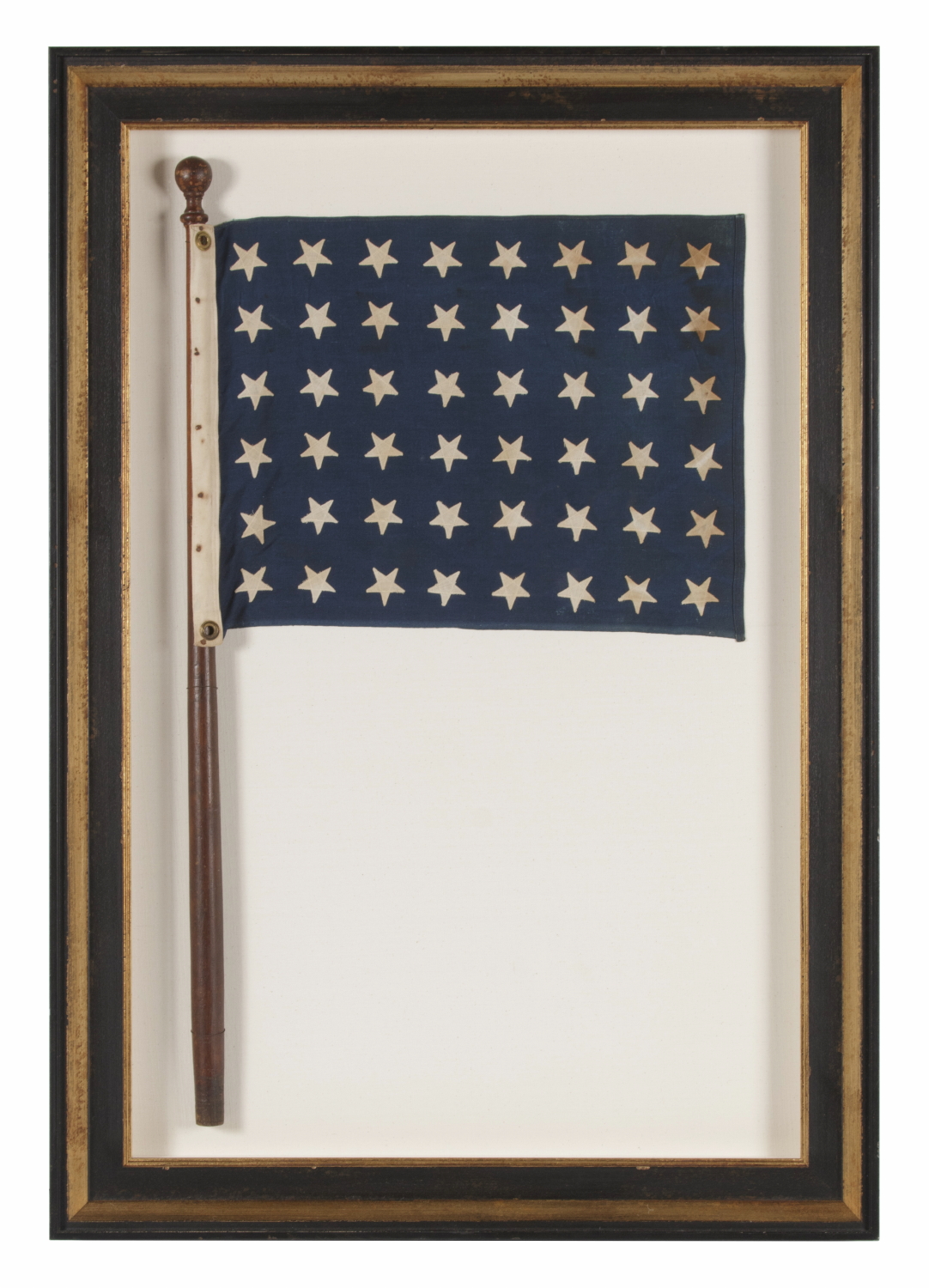
| |
48 STAR JACK ON THE ORIGINAL TURNED HARDWOOD STAFF OF A CHRIS CRAFT, 1930-1955 |
|
| Available: |
Sold |
| Frame Size (H x L): |
49.25" x 34" |
| Flag Size (H x L): |
Approx. 18" x 23.25" on a 40" staff |
|
| Description....: |
|
A "jack" is one of the three primary signals flown on a United States Navy ship. The practice comes from British Royal Navy tradition. When at anchor or moored, the jack is flown at the bow (front), the national flag or "ensign" is flown at the stern (back), and the commission pennant is flown from the at the main mast. When under way, the Jack is furled and the ensign may be kept in place or shifted to a gaff if the ship is so equipped.
The American Navy jack is a blue flag with a field of white stars. The design is the mirror image of the canton of an American national flag. In scale, the jack was meant to be the same size as the canton of the corresponding Stars & Stripes ensign with which it was flown.
The owners of private yachts sometimes emulated the Navy's use of traditional signals. This was perhaps especially true when the captain was a former navy man. This particular 48 star jack was not made for a U.S. navy boat, but for a small, private one. It is affixed, by means of small, metal upholstery tacks, to an elegant, turned, hardwood staff that would have been original to a Chris Craft, or a similar vessel of masterpiece quality. Tapered at both ends, it is precisely the type of staff used on some Chris Craft boats.
Measuring approximately 2 feet on the fly, the flag is very small in scale among pieced-and-sewn examples, is made of cotton bunting or a blended cotton fabric, and has been bound with machine stitching. The stars are made of cotton and double-appliquéd (applied to both sides) with a zigzag machine stitch. This became the primary way in which stars were applied during the 1890's and remained so until the close of WWII and after. There is a heavy canvas binding along the hoist with two brass grommets.
While cotton-based (moth proof) buntings such as this were available before WWII, they were not the norm until afterwards. This one probably dates sometime between the 1930's and the 1950's, with the latter end of this spectrum being more likely. The staff, however, appears to date sometime between the 1920's and the 50's. It may easily pre-date the flag, since flags would have been replaced often and owners of this type of boat tend to be fastidious about details.
Whatever the case may be, the blue color of the flag and the early patina of its shapely staff are very appealing.
The 48 star flag became official in 1912 following the addition of New Mexico and Arizona. 48 remained the official star count throughout WWI (U.S. involvement 1917-18), WWII (U.S. involvement 1941-45), and the Korean War (1950-53), until Alaska gained statehood in 1959 and the 49th star was added.
Mounting: The flag has been hand-stitched to 100% hemp fabric. The mount was then placed in a black-painted, hand-gilded and distressed Italian molding. A deep shadow box was made to accommodate the staff. The glazing is U.V. protective Plexiglas.
Condition: There is minor fading throughout. There is minor soiling, particularly in the top corner at the fly end. There are rust stains along the hoist from metal tacks used to affix the flag to the staff. Many of my clients prefer early flags to show their age and history of use. |
|
|
|
| Collector Level: |
Beginners and Holiday Gift Giving |
|
| Flag Type: |
Sewn flag |
|
| Star Count: |
48 |
|
| Earliest Date of Origin: |
1930 |
|
| Latest Date of Origin: |
1955 |
|
| State/Affiliation: |
Arizona |
|
| War Association: |
|
|
| Price: |
SOLD |
|
| |
Views: 1937 |
|
|
|

